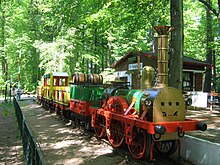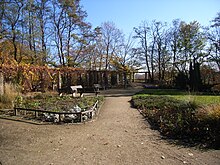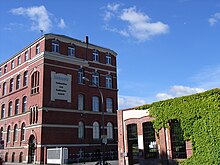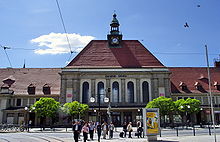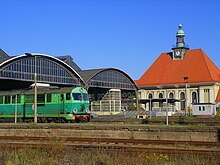Südstadt (Görlitz)
|
South City
South City City of Goerlitz
|
|
|---|---|
| Coordinates: 51 ° 8 ′ 35 ″ N , 14 ° 58 ′ 25 ″ E | |
| Height : | about 200–220 m above sea level. NN |
| Area : | 2.6 km² |
| Residents : | 9005 (June 30, 2016) |
| Population density : | 3,463 inhabitants / km² |
| Postal code : | 02826 |
| Area code : | 03581 |
|
Location of the southern part of Görlitz
|
|
|
Aerial view of Görlitz Südstadt - south (on the right in the photo) of the railway line
|
|
The South City and South City is situated in the south of the center Görlitz district with about 9000 inhabitants (as of June 30 2016), which in the north on the railroad tracks Węgliniec-Goerlitz and Gorlitz Dresden and to the train station , on the south by the vineyard , in the east on the border river Neisse and in the west on the districts of Biesnitz and Rauschwalde .
Its appearance is characterized by the cohesive Wilhelminian style development, which also allows conclusions to be drawn about its development at the end of the 19th century. It was created as a result of the expansion of the city towards the south after Görlitz was connected to the Prussian and Saxon railway network.
Furthermore, the surrounding villa belt forms the southern border of the historic Görlitz inner city development. The more southern parts of the city or district were only incorporated into the urban area at a later point in time, such as Weinhübel (1949) or Hagenwerder (1994).
Attractions
Sacred buildings
Worth seeing in the southern part of the city are its three churches, each of which represents a different architectural style: the Catholic Cathedral of St. James , the Evangelical Lutheran Church of the Holy Spirit and the Evangelical Church of the Cross . The St. Jakobus Cathedral, often just called Jakobuskirche in the vernacular, is a red brick building that rises to the south of the Görlitz train station, clearly visible on a hill above the rest of the buildings. On June 6, 1898 the foundation stone was laid for the new Catholic church in neo-Gothic style. Almost half a century later - in 1945 the church was damaged by artillery fire and duds in the nave. a. all windows were destroyed, the tower and roof damaged and 240 organ pipes destroyed. Since 1994 the Jakobuskirche has been the parish church as well as the cathedral and seat of the bishop of the diocese of Görlitz , which was newly established on July 8, 1994, and the seat of the cathedral chapter . The church tower with a height of 68 m can also be climbed and offers a good view of the inner and old town of Görlitz.
Opposite it is the smaller Holy Spirit Church between Sattigplatz and Zittauer Straße; it is the seat of the Evangelical Lutheran (old Lutheran) parish. The Heilig-Geist-Kirche in Görlitz was built between 1905 and 1906, in the Nordic-Neo-Romanesque style and under the influence of Art Nouveau. The reason was the demolition of the old hospital church, opposite the Peterskirche on the eastern bank of the Neisse. The old Lutheran congregation had held its service there since 1854. The interior fittings (organ, altar with pulpit, benches, bell, baptismal font) from the old hospital church were built into the Heilig-Geist-Kirche.
A Protestant church can be found in the southwest of the district - the Kreuzkirche. It was built between 1913 and 1916 in a mixture of Art Nouveau , Neoclassicism and Modernism as a result of an architecture competition by Rudolf Bitzan from Dresden . From its viewing platform at a height of 38 meters, the tower of the Kreuzkirche offers a wonderful panoramic view of the city and, depending on the weather, of the surrounding area.
The cemetery of the Jewish community is also located in the west of the Südstadt, on Biesnitzer Straße at the level of the Büchtemannstraße tram stop. There is a memorial on it for the Jewish prisoners who were murdered in the Görlitz subcamp and buried in the cemetery.
Streets and buildings
Numerous art nouveau villas can be seen on both sides of the avenue-like Goethestrasse. Not far from Goethestrasse is the Landskron brewery on whose large brewery complex concerts, exhibitions and festivals are held regularly. Most of the events take place in the so-called KULTurSCHMIEDE (often just called the Kulturbrauerei), the hall can accommodate up to 1,300 guests and is also used by companies or for prom.
Along with Goethestrasse, Biesnitzer Strasse is one of the most famous streets in the southern part of the city. It begins at Zittauer Strasse, near the Luisenstift, is briefly interrupted by Sechsstädteplatz and merges into Promenadenstrasse at the Eiswiese. It is also lined with trees on both sides of the street and between the lane and the pedestrian or bike path are the tracks of the Görlitz tram towards the city center or Landeskrone, Görlitz's local mountain. The street is given a special character by the interplay of the connected lines of Wilhelminian style or Art Nouveau houses and the tram that runs here.
The Luisenstift is located on Biesnitzer Straße, near the intersection with Zittauer Straße. Today's retirement home was built in 1848 as a classicist villa. The extension of a side wing in 1892 created today's building ensemble, which in the same year served as a retirement home for wealthy, single women. A few years ago, a new building enabled the complete renovation of the old building, including the striking clock tower.
Neisse Viaduct
In the northeast of the Südstadt, east of the train station, you will find the city's most imposing Neisse crossing, the Neißeviadukt - a railway bridge on the Węgliniec – Görlitz railway line . It was planned and built by Gustav Kießler between 1844 and 1847 as a result of the connection between Görlitz and the Saxon and Prussian railway networks. With a length of 475 m it spans the 35 m lower lying Neisse valley, which also represents the state border. In the last days of the war in 1945 (May 8, 1945), the viaduct was blown up by members of the Waffen SS , despite the long foreseeable defeat of the Hitler Empire . As a result of its reparation claims, the Soviet Union dismantled all overhead lines that had enabled the line between Breslau and Görlitz to be continuously electrified before the demolition. It was not until the 1950s that the blasted arches of the bridge were rebuilt and again enabled rail traffic between now two different countries. The bridge is under the administration of the Polish state railway infrastructure company PKP PLK , which is also responsible for any repairs. In 2007 the bike and hiking trail along the Neisse, which also runs under the viaduct, had to be closed in winter. There was a risk that stones could be blown out of the masonry by frost.
In 2013, the viaduct was extensively renovated by the Polish side and the track system renewed.
Recreation & leisure
Vintage park railway
A popular destination for families is the Görlitzer Oldtimer Parkeisenbahn , not far from the Görlitzer brewery and the vineyard house with the lookout tower that can be entered again. The Park Railway is a replica of the first steam locomotive used in Germany - the Adler , which operated between Nuremberg and Fürth. The idea for this so-called pioneer railway in GDR times came from an engineer from Görlitz who presented his plans to the city council in the 1970s. This approved the project and through the financial and material support of numerous companies in the city and in the surrounding area, the project could be implemented in a time of only one and a half years and the old-timer pioneer railway started operating on June 1, 1976.
Up to 70 students worked in the new working group of the pioneer railway , but the train driver was provided by the Görlitz depot of the Deutsche Reichsbahn until 1990 . After the reunification, the Görlitzer Oldtimer-Parkeisenbahn association was founded in June 1991, which took over the entire operation of the Parkeisenbahn in May 1993.
Parks
Mountain garden
Not far from the Teufelsbrücke near Zittauer Straße you can reach the Berggarten via a narrow passage between the properties at Heinzelstraße 7 and 8 . It was laid out in 1940 by the Görlitz garden architect and later horticultural director Henry Kraft as a private garden for a merchant and at that time belonged to the property at Heinzelstrasse 9. In 1961, the facilities were revised again by Henry Kraft and finally handed over to the public as Bergarten. The area is about one hectare and sloping to the south. The meadows with their well-placed deciduous and coniferous trees invite the visitor to linger.
Peace height
The Friedenshöhe is located above the Neisse at the level of the Neisse Viaduct. The name for the lookout point in front of the log cabin recalls the end of the Franco-Prussian War in 1871. The nephew of the later Emperor Wilhelm I , Prince Friedrich Karl of Prussia , also took part in this war as commander. In 1891 Görlitz, then Prussian, erected a memorial to this nephew on the plateau on the Neisse side in front of the log house. However, it fell victim to the armaments industry as early as 1942. In 1952 the park was redesigned by Henry Kraft and received its current appearance with a pergola above the railway tracks over the Neisse Viaduct with a very good view over the Neisse valley, as well as beds with perennials and summer flowers. From the park there is also a path down to the Neisse.
Kreuzkirchenpark
South of the Kreuzkirche is the sloping Kreuzkirchenpark . After the expansion of the city towards the south, the new residential area required recreational space, so in 1913 the gardening director Heinrich Diekmann presented the model of a south-facing park. It was also hoped that the villa plots advertised nearby would be upgraded. Work began as early as 1914 and was largely completed in 1916. The slope was planted with many shady trees and a children's floodplain was built for children, but this no longer exists today. Remnants of the pool can still be found on today's lawn playground, the old lawn.
In winter the slope is very popular with children, especially as a toboggan hill.
Schellergrund
Opposite the Landskron brewery along the Görlitz – Zittau railway line is the Schellergrund , a small park that represents the remainder of a no longer recognizable wide valley towards the Neisse. The filling of this valley was made necessary by the construction of the railway line and the Landskron brewery. The rest of the valley was not filled in but restructured into a park. This was also in the interests of the local brewery director Theodor Scheller and his son Walter. They donated large sums of money and trees. In 1930/31 the area at the Aktienbrauerei was redesigned and expanded according to plans by the gardening director Diekmann, and since 1932 people in Görlitz have been talking about the Schellergrund .
This small park consists of more and less steeply sloping overgrown slopes, meadows and a roundabout with a flight of stairs at the lowest point. There is an old rhododendron population around the outside staircase . The Schellergrund with its old trees, the poor meadows and overgrown parts of the park is home to a multitude of protected bird species.
Vineyard area
The vineyard area stretches for about 1.5 km, always along the Neisse, from the Obermühle in the southern city center to the Weinlache at the Stadium of Friendship in Weinhübel. As early as 1834, the so-called beautification deputation of the city of Görlitz was concerned with the facilities of the Obermühlenberge, as the northern vineyard area was still called at that time. She suggested redesigning the area above the Obermühle. Depending on the financial possibilities of the city, plots of land were acquired from year to year, redesigned and made accessible by stairs and paths.
The rocky slopes to the Neisse were originally almost bare, but over the years a varied deciduous forest with a few interspersed conifers has emerged . One of the architectural highlights of the facilities since 1847 has been the Neisse Viaduct, which spans the Neisse Valley.
At the beginning of the 20th century, a bathing establishment was built in the Weinlache , but it was demolished in 1945. A year later, the Volksbad was opened a little further west. Above the Weinlache on the vineyard, the vineyard tower rises from the forest. It belongs to the Weinberghaus excursion restaurant, which was built in 1890 . The restaurant is currently not open due to its ruinous condition, but the tower was restored by a citizens' initiative and is accessible again.
Along the banks of the Neisse is the Inselweg, part of the German Unity - Görlitz - Aachen long-distance hiking trail , as well as part of the Oder-Neisse cycle path . From here you can easily access the vineyards, and you can easily reach the Berggarten, Friedenshöhe and Schellergrund.
Animal park
The southern part of the city also has something in store for animal and nature lovers, the Görlitz nature reserve zoo . The zoo is home to a large number of native and exotic animal species and, with around 5 hectares, is one of the smallest zoos in Germany. Nevertheless, print media such as Stern (31/2000) and GEOlino (4/2000) have already attested a very high quality. In the big zoo test of the star, it took first place in the category of smaller zoos in 2008 and in the children's magazine GEOlino it was recommended as the only Saxon zoo along with nine other German zoos as being particularly child-friendly.
Sports
One of the newest Görlitz sports facilities is located at the water tower between Biesnitzer Straße and Zittauer Straße - the Neißebad. The people of Görlitz had to wait several years for a new swimming pool, as the old swimming pool on Fichtestrasse, a few meters from the new location, had several serious defects. The new swimming pool was opened on October 19, 2007 in the presence of the Saxon Interior Minister Albrecht Buttolo . It has a sports pool with six lanes of 25 m each, a 1-meter diving board, a 3-meter platform, a teaching pool, a parent-child area and a wellness area.
The sports hall of the vocational school center is also one of the younger Görlitzer sports halls, it is used for both school and club sports (e.g. Görlitzer Turnverein 1847 eV, SV Koweg ). This facility consists of two halls one above the other and has a capacity for around 50 spectators.
The Görlitzer Turnverein 1847 e. V. also trains in the venerable, smaller gym on Kunnerwitzer Straße, behind the Görlitzer train station.
The Eiswiese is the soccer field of the southern part of the city. SSV Germania Görlitz and Postsportverein Görlitz e.V. train on the ice meadow. V.
Establishments
Siemens steam turbine plant
The largest operation in the southern part of the city is the SIEMENS AG turbine plant . In 2008 the plant employed 821 people and more than 60 trainees.
It has a long tradition in the field of mechanical engineering. It all began in 1847 with the construction of steam engines only. It was not until 1910 that steam turbines were added to the production program. In 1945 the factory was dismantled and production only started again in 1951.
In 1991 it was taken over by SIEMENS AG. Today it is part of the SIEMENS Power Generation and industrial steam turbines are manufactured here and a competence center for turbo sets and compressors is operated.
KEMA
Another mechanical engineering company is BMS GmbH - KEMA Görlitz (until 1945: Maschinenfabrik Raupach ), which has been developing and building machines for the ceramics industry (rolling mills & extruders ), but also for other industries worldwide , since 1878 .
The company was founded in 1878 by Richard Raupach under the name Richard Raupach Maschinenfabrik Görlitz , at that time he converted old and ineffective boiler systems and steam engines with three to four locksmiths. As early as 1903, after the company moved to a larger area on Zittauer Strasse, the workforce had grown to 250 employees, and Richard Raupach, who later became the Royal Councilor of Commerce , established a foundation for long-term employees and their widows and orphans. The company has been honored with gold and silver medals at numerous exhibitions.
During the two world wars , the following armaments were produced in the factory: during the First World War artillery ammunition and other war materials, and during the Second World War armaments orders for the Navy.
In 1945 the factory was dismantled by the Soviet Union and restructured in 1949 to VEB KEMA (ceramic machine building). In 1989 there were around 550 employees at VEB KEMA, after which the plant was sold to the Eirich Group.
Landskron Brewery
see Landskron Brewery .
Local transport company
The city's local transport company, Görlitzer Verkehrsbetriebe (GVB), operates the city's largest bus and train depot south of the zoo. The depot consists of a modern vehicle shelter and an older clinker building, which also houses several vehicle and repair stands. The headquarters of the railway company CONNEX Sachsen was also located in the administrative building in front of the depot. However, this location was called into question because at the end of 2008 the lines operated by CONNEX in Eastern Saxony were completely taken over by the Ostdeutsche Eisenbahngesellschaft ODEG. CONNEX Sachsen changed its name to Veolia Verkehr Regio Ost and moved its headquarters to Leipzig.
Since the timetable change in December 2008, ODEG has also had an operations workshop in Görlitz for its fleet in Lusatia, for which it acquired the former railway works from Deutsche Bahn in October 2008.
schools
- Melanchthon School (Elementary & Middle School)
- Vocational Schools Christoph Lüders (Vocational School Center Economy / Social Affairs and Vocational School Center Technology)
Day care centers
- Südstadtmäuse day care center
- After- school care center 6
- DRK Kindergarten SieKids Turbienchen
- Catholic day care center St. Jakobus
- Protestant day-care center in the Paul-Gerhardt House
traffic
The federal road B99 runs through the southern part of the city and connects Görlitz to the north with the A4 motorway and extends south to Zittau and the Polish / Czech border.
The southern part of the city is crossed by two trams and numerous bus routes . It is integrated into the urban network of the Görlitzer Verkehrsbetriebe as well as the regional network of the Oberlausitz regional bus and the Dreiländereck transport company .
It is served by the following lines:
City traffic:
- Tram line 1: Weinhübel - Königshufen, NeißePark
- Tram line 2: Biesnitz, Landeskrone - Königshufen, Am Wiesengrund
- Bus line B: Rauschwalde - Klinikum, Virchowstraße
- Bus line N: Rauschwalde - Biesnitz, Landeskrone (night traffic, runs between 7 p.m. and midnight)
Overland lines:
- Line 21: Görlitz - Ostritz - Hirschfelde - Zittau
- Line 130: Görlitz - Reichenbach - Löbau
- Line 136: Görlitz - Schöpstal - Kodersdorf
- Line 137: Görlitz - Markersdorf - Deutsch Paulsdorf
- Line 146: Görlitz - Pfaffendorf - Friedersdorf
- Line 147: Görlitz - Bernstadt - Herrnhut
Due to the location of the district at Görlitzer Bahnhof, there is an almost hourly connection to the train service of the Länderbahn (" Trilex ") and the East German Railway Company ODEG in the direction of Dresden Hbf , Cottbus , Hoyerswerda and Zittau.
- Regional train Trilex TL 60: Görlitz - Löbau - Bautzen - Dresden Hbf
- East German Railway 60V (amplifier traffic): Görlitz - Löbau - Bautzen - Bischofswerda
- East German Railway 64: Görlitz - Niesky - Hoyerswerda
- East German Railway 65: Zittau - Görlitz - Weißwasser - Cottbus
- Regional express Trilex TLX 1: Görlitz - Löbau - Bautzen - Dresden Hbf
Cross-border regional rail transport offers:
Since December 2015, the trains of the Polish railway have been running from Węgliniec not only to Zgorzelec , but also to Görlitz. The German “Trilex” has also resumed operations from Dresden via Görlitz to Węgliniec.
Individual evidence
- ↑ a b goerlitz.de: Statistical monthly figures for the city of Görlitz, month December 2011 . (No longer available online.) Archived from the original on October 18, 2012 ; Retrieved June 11, 2012 .
- ↑ termine.orgel-information.de: Kath. Jakobus Cathedral . (PDF; 3.6 MB) (No longer available online.) Formerly in the original ; Retrieved October 7, 2012 . ( Page no longer available , search in web archives )
- ↑ lutherische-kirche-goerlitz.de: The Holy Spirit Congregation today . (No longer available online.) Archived from the original on August 13, 2012 ; Retrieved October 7, 2012 .
- ↑ denkmalschutz.de: Luisenstift . (PDF; 94 kB) Retrieved October 7, 2012 .
- ^ Sächsische Zeitung with a report on Henry Kraft
- ↑ Green spaces and parks in Görlitz ( Memento from March 7, 2009 in the Internet Archive )
- ↑ Star Zoo Test 2008
- ^ Sächsische Zeitung with a report on the Siemens plant
- ^ Siemens AG - Görlitz plant
- ^ Sächsische Zeitung with a report on Richard Raupach
- ^ Sächsische Zeitung with a report on ODEG









